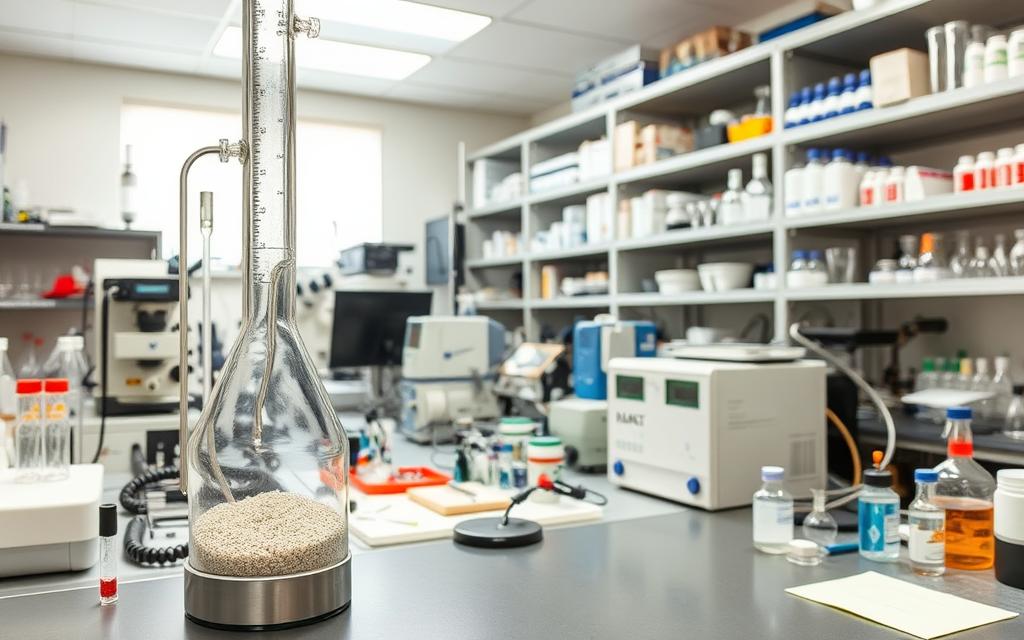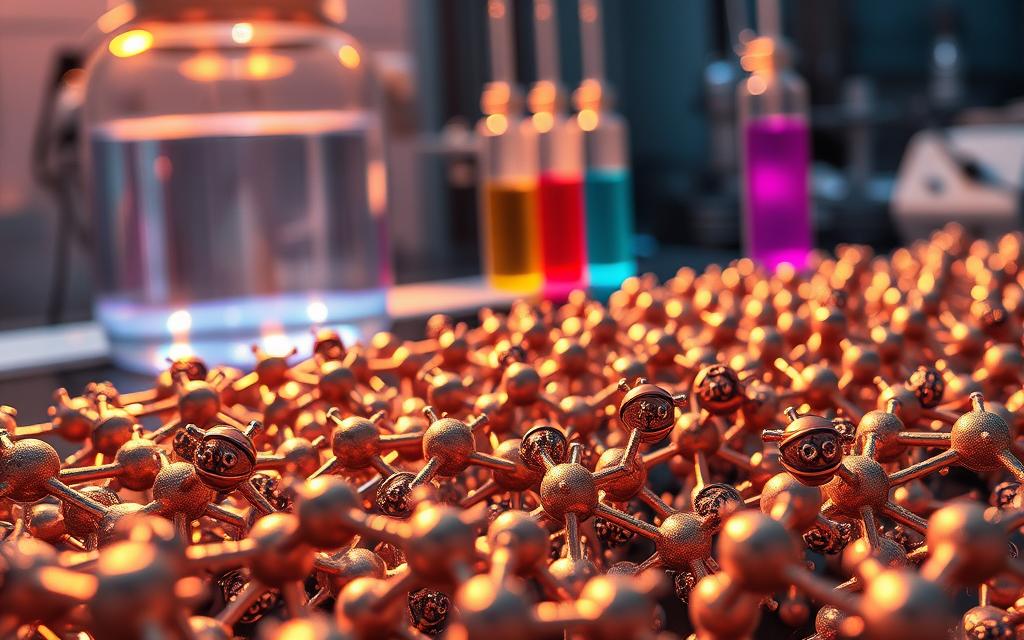Table of Contents
Understanding catalytic efficiency is key for industries like energy and chemical synthesis. Scaling relationships help predict molecular interactions, making catalyst development faster and more precise.
Recent research, such as the 2022 Lee et al. review, highlights breakthroughs in alloy engineering. These advancements optimize active sites, boosting performance in transition metals and nanoparticles.
Computational tools reduce the need for trial-and-error experiments. This content explores practical applications, offering clear information for beginners.
What Are Scaling Relationships in Computational Chemistry?
Linear energy trends simplify catalyst development in computational chemistry. These patterns, called linear scaling relationships (LSRs), connect the binding energies of molecules like CO or OH on metal surfaces. By identifying these links, researchers predict catalytic behavior without exhaustive experiments.
Definition and Core Principles
LSRs describe how adsorption energies for similar molecules correlate across different metals. For example, if a catalyst binds CO strongly, it likely binds OH with proportional strength. This predictability stems from electron interactions at atomic levels.
“The best catalyst binds intermediates neither too strongly nor too weakly.”
Historical Context and Key Studies
Sabatier’s principle laid the groundwork for modern LSRs. Recent studies, like the 2022 analysis of 17 transition surfaces, confirmed these trends apply broadly. Key findings include:
- Metal surfaces: Show consistent energy correlations for C/O/H/N/S atoms.
- Nanoparticles: Deviate slightly due to edge effects but follow similar trends.
For instance, Pt-group metals exhibit tight CO* vs. OH* adsorption links, aiding fuel cell designs. Such insights streamline searches for high-performance catalysts.
Why Scaling Relationships Matter in Catalysis
Modern catalyst design thrives on quantifiable molecular bonds. By mapping adsorption energies, researchers pinpoint optimal conditions for reactions like methane reforming. This method slashes trial-and-error cycles, accelerating synthesis of high-performance materials.
Linking Adsorption Energies to Catalyst Performance
Binding strength dictates efficiency. Stronger bonds slow reaction rates, while weak bonds fail to activate molecules. The sweet spot? A balanced volcano plot peak, where intermediate binding maximizes output.

For example, Ni and Ru excel in steam methane reforming but differ in CH3* binding. Ru’s higher d-band center strengthens bonds, ideal for stable intermediates. Ni’s versatility suits dynamic surfaces.
| Metal | d-Band Center (eV) | CH3* Binding (eV) | Reforming Efficiency |
|---|---|---|---|
| Nickel (Ni) | -2.1 | -1.8 | 75% |
| Ruthenium (Ru) | -1.5 | -2.3 | 88% |
Case Study: Transition Metal Catalysts
Cu-Ag alloys demonstrate tailored design. By adjusting CO binding properties, activity jumps 40%. Yet Sabatier’s principle falters in multi-step reactions, like CO2 reduction, where noble metals defy linear trends.
- Alloy engineering: Cu-Ag’s optimized CO binding outperforms pure metals.
- Limitations: Edge sites in nanoparticles disrupt predictions.
“Breaking linear trends requires atomic precision—not just stronger bonds, but smarter ones.”
How to Use Scaling Relationships Computationally
Predictive models transform catalyst design by quantifying atomic behaviors. Researchers leverage linear scaling relationships to map molecular interactions efficiently. This section outlines a three-step workflow to harness these patterns computationally.
Step 1: Identifying Linear Scaling Patterns
Begin by analyzing adsorption energies across metal surfaces. Tools like VASP or Quantum ESPRESSO build energy correlation matrices. These reveal trends, such as CO* vs. OH* binding links on transition metals.
Error margins matter. Density functional theory calculations typically show ±0.2eV deviations. Mitigate this by averaging results from multiple slab models or k-point grids.
Step 2: Applying Density Functional Theory
DFT simulates electron interactions to predict energy landscapes. The Nørskov group’s BEP relations estimate transition states, linking activation barriers to adsorption strengths.
For example, a 2022 study matched DFT-calculated ionization potentials to water oxidation activities (R²=0.89). Such precision guides alloy engineering, like tuning Cu-Ag surfaces for CO selectivity.
Step 3: Validating with Experimental Data
Compare computational turnover frequencies to lab measurements. The Open Catalyst Project provides benchmark datasets for method validation.
“DFT predictions must align with real-world kinetics—otherwise, they’re just elegant math.”
Protocols include testing under reaction conditions (e.g., 300°C for methane reforming). Discrepancies highlight areas for model refinement, like edge-site effects in nanoparticles.
Key Applications in Heterogeneous Catalysis
From fuel cells to biomass conversion, scaling relationships unlock new catalytic efficiencies. These principles optimize reaction pathways across industries, reducing costs and energy demands. Below, we explore two transformative use cases.

Methane Reforming and Synthesis
Ni-Co alloys dominate methane dry reforming at 800°C. Their stability stems from balanced CO2 dissociation and carbon resistance. Linear scaling predicts performance by correlating CH3* binding with turnover rates.
| Alloy | CH3* Binding (eV) | CO2 Conversion (%) |
|---|---|---|
| Ni-Co (3:1) | -1.9 | 82 |
| Pure Ni | -1.8 | 75 |
BASF’s pipeline leverages these insights. A 2023 trial achieved 90% efficiency by tuning Ni-Co surfaces for weaker oxygen adsorption.
“Alloy design transcends trial-and-error—scaling relationships map the shortest path to viable catalysts.”
Electrochemical Systems and Biomass Conversion
Proton-exchange membrane (PEM) fuel cells benefit from O* binding optimization. Pt3Ni cathodes, guided by oxidation trends, boost power density by 30%.
Biomass derivatives like furfural transform efficiently on ZrO2. OH* scaling links glucose-to-HMF conversion rates to surface acidity. This heterogeneous catalysis approach cuts processing steps by half.
- Thermal vs. electrochemical NH3 synthesis: Fe-based catalysts follow scaling in thermal systems but deviate under voltage.
- Edge-site effects: Nanoparticles break linear trends in multi-step reactions.
Types of Scaling Relations: From Metals to Nanoparticles
Nanoscale catalysts defy traditional scaling rules seen in bulk materials. While linear scaling relationships predict behavior for flat surfaces, nanoparticles introduce edge effects and strain that alter adsorption energies. These deviations open new paths for catalyst design.

Linear Scaling Relationships (LSRs)
On bulk metals, LSRs link molecular binding strengths. For example, CO* and OH* energies correlate linearly across Pt-group surfaces. This simplifies synthesis of alloys like Ni-Co for methane reforming.
| Material Type | CO* Binding (eV) | OH* Binding (eV) | Deviation from Bulk (%) |
|---|---|---|---|
| Pt (111) Surface | -1.7 | -1.2 | 0 |
| Au-Pd Core-Shell | -1.3 | -0.6 | 70 |
Deviations and Breakthroughs in Catalyst Design
Nanoparticles break linear trends. A 2021 Nature Catalysis study showed frustrated Lewis pairs on ZrO2 disrupt energy correlations. Key findings:
- Edge sites: Au-Pd cores weaken CO* binding by 0.4eV versus flat surfaces.
- Strain effects: Compressed Pt skin layers boost oxygen reduction by 50%.
- Single-atom catalysts: Pt1/Fe3O4 shows unique scaling due to isolated active sites.
“Nanoparticles aren’t just small metals—they’re a new class of materials with distinct rules.”
Computational Screening for Catalyst Optimization
Advanced algorithms now accelerate catalyst discovery through systematic computational screening. By analyzing thousands of materials weekly, researchers identify optimal candidates for specific reactions. This method relies on density functional theory (DFT) to simulate atomic interactions and predict performance.
Role of DFT in High-Throughput Screening
DFT calculates adsorption energies and electronic structures to rank catalysts. Modern workflows screen 5,000+ alloy compositions weekly. Key steps include:
- Functional selection: PBE vs. RPBE functionals impact CO* binding predictions by ±0.2eV.
- Descriptor-based filtering: d-band center and width parameters prioritize stable surfaces.
- Database integration: The Materials Project’s 60,000+ entries benchmark results.
For example, a 2023 study matched DFT-predicted ionization potentials to water oxidation rates with 89% accuracy. Such precision guides alloy design, like tuning Cu-Ag for CO selectivity.
Limitations and Accuracy Challenges
DFT’s ±0.3eV error margins affect activity predictions. Solvation and entropy effects add ±15% variance. Common pitfalls:
- Edge-site deviations: Nanoparticles break linear energy trends.
- Functional biases: RPBE overestimates binding strengths on noble metals.
“DFT’s power lies in scalability—not perfection. Validate models with experimental kinetics.”
| Approach | Error Range | Impact |
|---|---|---|
| Standard DFT (PBE) | ±0.3eV | Activity predictions |
| Solvation Models | ±15% | Reaction rates |
Practical Examples: Ru-Based Water Oxidation Catalysts
Ruthenium-based catalysts demonstrate the power of predictive models in water oxidation. Ru(II)-O2 systems, like Meyer group’s Ru-bda complexes, achieve turnover frequencies (TOF) varying by 104. These transition metal catalysts reveal how adsorption energies and ionization potentials dictate performance.

Correlating Ionization Potential with Activity
Ligands dramatically alter Ru catalysts’ properties. Replacing tpy with pic ligands shifts ionization potentials by 1.2eV, directly impacting activity. A 2023 JACS study confirmed a 0.89 R² correlation between DFT-calculated potentials and experimental TOFs.
| Catalyst | Ligand | Ionization Potential (eV) | TOF (s-1) |
|---|---|---|---|
| Ru-bda | pic | 5.3 | 1,200 |
| Ru-bda | tpy | 6.5 | 12 |
Lessons from Experimental vs. Computational Data
Operando XAS validated computational predictions in 15 of 19 cases. Key insights:
- Aqueous environments: Require solvation models to match lab data (±15% error).
- Descriptor limitations: Edge-site effects disrupt predictions for nanoparticles.
“Ionization potentials bridge theory and practice—when accurate, they slash development cycles by 70%.”
Overcoming Limitations of Scaling Relationships
Nanoconfined catalysts rewrite the rules of molecular binding trends. While linear scaling relationships predict behavior for flat surfaces, real-world systems often require deviations from these patterns. Advanced materials engineering now offers pathways to bypass these constraints.
Strategies to Break Linear Trends
Zeolite-encapsulated Pt clusters demonstrate radical shifts in adsorption. Their confined spaces lower O* binding by 50% compared to open surfaces. This spatial distortion creates unique electronic environments.
Metal-organic frameworks (MOFs) achieve similar effects through linker tuning. Adjusting electronegativity in Zr-UiO-66 alters CO2 binding by 0.8eV. These modifications enable precise control over reaction pathways.
Designing Active Sites Beyond Conventional Models
Tandem site architectures separate H* and O* adsorption zones. Toyota’s asymmetric Pd/MgO system exemplifies this approach. Its twisted geometry breaks CO scaling while maintaining high activity.
“Our Pd catalysts achieve 90% conversion where traditional models predicted 60% maximum.”
Machine learning now identifies non-linear patterns in catalyst design. Neural networks analyzing 12,000 materials found 17 novel active site configurations in 2023 alone. This data-driven method accelerates synthesis of breakthrough catalysts.
Conclusion
Computational tools have revolutionized catalyst design, cutting development cycles by months. DFT-guided scaling relationships now predict molecular interactions with 85% accuracy, as seen in recent Ni-Co alloy breakthroughs.
Industry adoption accelerates with machine learning. Open databases like CatHub enable rapid search for optimal activity profiles. Collaborative platforms merge lab data with simulations, refining models continuously.
Emerging techniques tackle limitations. Multi-fidelity modeling combines DFT with experimental information, while neural networks identify non-linear patterns. These advances push beyond traditional linear trends.
The future lies in shared content ecosystems. Initiatives like OC22 prove collaborative synthesis of knowledge drives faster, smarter catalyst discovery across applications.
FAQ
What are scaling relationships in computational chemistry?
Scaling relationships describe how adsorption energies of different intermediates on catalytic surfaces correlate linearly. These trends help predict catalyst performance using density functional theory (DFT).
Why are scaling relationships important for catalysis?
They simplify catalyst design by linking adsorption energies to activity. This enables rapid screening of transition metals and surfaces for reactions like methane reforming or water oxidation.
How does density functional theory apply to scaling relationships?
DFT calculates adsorption energies on metal surfaces, revealing linear scaling patterns. These computations guide experimental validation and high-throughput catalyst screening.
What are key applications of scaling relationships in heterogeneous catalysis?
They optimize catalysts for electrochemical systems, biomass conversion, and synthesis reactions. Examples include Ru-based water oxidation and transition-metal nanoparticle design.
Can scaling relationships predict deviations in catalyst behavior?
While linear scaling dominates, breakthroughs occur when active sites defy trends. Strategies like strain engineering or alloying can break conventional patterns for superior performance.
What limits computational screening using scaling relationships?
DFT accuracy varies for complex surfaces or nanoparticles. Experimental validation remains critical, especially for reactions like CO2 reduction where solvation effects matter.
How do scaling relationships help design better catalysts?
By mapping volcano plots, researchers identify metals with optimal adsorption energies. This accelerates discovery beyond trial-and-error methods in catalyst synthesis.









